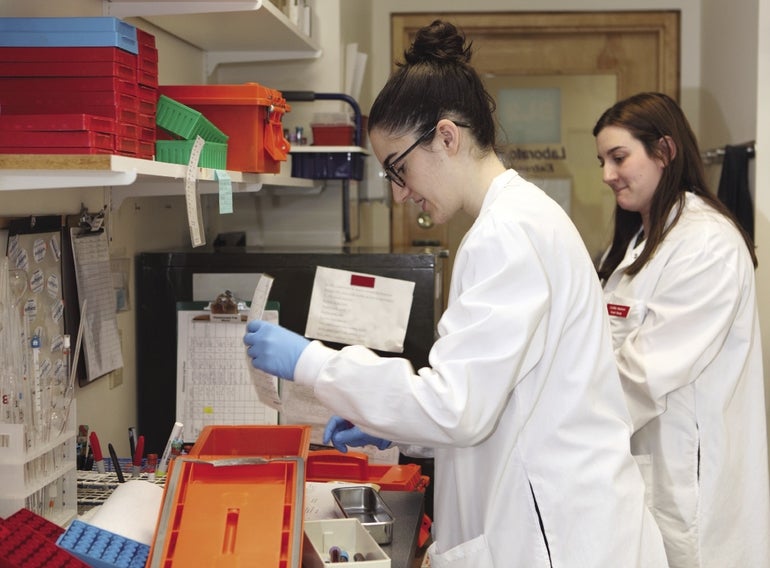More than seven decades ago, about two-thirds of Framingham’s adult population signed up for a first-of-its-kind medical study. More than 5,000 of them would be tracked for cardiovascular health over a long course of time.
Those participants couldn’t have known just how long the Framingham Heart Study would last or how impactful doctors’ findings would become.
By 1960, doctors at the program would determine smoking was a heart disease risk, a finding that came four years before the landmark U.S. Surgeon General’s ruling requiring cigarettes to come with clear health warnings.
Findings in the ’60s included risks of obesity and benefits of exercise. Later, doctors found connections between high blood pressure and higher stroke risks and between good cholesterol and lower risks of premature death.
Now, the Framingham Heart Study is getting an extension to allow it to continue to monitor thousands of participants and look for potentially troubling new signs. The National Heart, Lung and Blood Institute said in April it is extending the contract for another six years, including $38 million in funding.
The extension allows the study to begin examining older participants for signs of aging by looking at liver fat, platelet function, arterial stiffness and other factors.
That extension is critical for continued research, doctors there said.
“We have generated more data in these past two years than in the first 68 years,” said Dr. Daniel Levy, the study’s director for more than three decades.
Starting with $500K
The study has become a trove of vital information for cardiovascular experts far beyond Framingham. Researchers across the world have applied for access to the study’s information, Levy said.
The American Heart Association marked the study’s 70th anniversary last year by calling the Framingham Heart Study “the study and the town that changed the health of a generation.”
“It’s a landmark study,” Levy said. “It’s a national treasure.”
Little was known about heart disease and other cardiovascular issues in the 1940s. So little was known, in fact, when President Franklin D. Roosevelt died in 1945 with severely high blood pressure, little could have been done to improve his health because no medication existed yet to lower blood pressure, Levy said.
At the time, Levy said, the leading causes of death were related to infectious disease. Now it’s heart disease. More than 600,000 Americans died of heart disease in 2016, according to the Centers for Disease Control & Prevention.
The study began in 1948 with a $500,000 federal grant for heart disease research, with Framingham ultimately chosen because of its proximity to major research in Boston and its typical-America demographics, according to a book on the study by Dr. Benjamin Yang.
Early exams included typical looks at blood pressure, height, weight and lung function, and participants were asked about eating, sleeping and smoking habits, according to Yang. Detailed participants’ dieting histories weren’t included until the fourth round of testing.
Today, the study has bone density tests and brain, heart and abdomen MRIs.
All those test results have produced enough information to be cited in nearly 3,700 published journal articles, according to the American Heart Association. Findings include not only heart health but dementia and Alzheimer’s disease.
Four generations of participants
If the study could seem inconvenient or even intrusive, that’s not how participants tend to see it. More than 15,000 have taken part at some point.
“I’ve never heard anyone say they thought it was inconvenient. They look forward to going,” said Dennis Giombetti, the chair of the Framingham City Council and a second-generation participant in the study.
“It’s remarkable how many people around the world know of Framingham because of the heart study,” he said.
Roughly 4,000 people participate in the study today, typically undergoing exams every three years. Even those who’ve moved out of the area still take part, with staff working to arrange exams during summer or holiday visits.
Participants and their family members have gotten used to stopping by the program’s white building off Union Avenue just north of downtown, where roughly 70 people conduct the exams.
“Because it’s multigenerational, there’s a strong sense of belonging. There’s a sense of altruism,” said principal investigator Dr. Vasan Ramachandran.
Doctors at the Framingham Heart Study have continued monitoring not only that first group but two generations since. Only roughly 20 of the original participants are still living, but their children have participated since 1971, and their grandchildren since 2002.
Demographic limitations from the study’s outset have been fixed. The first cohort was all white, so later generations have included a broader ethnic range of participants, Ramachandran said.
The latest government funding may not have been a surprise for study leaders, but its future wasn’t guaranteed.
Boston University, whose School of Medicine has staffers working on the study, proposed selling data and genetic information about participants in 2000, an action that would have breached strict privacy protocols since the study’s outset, according to Yang. But BU dismissed those plans.
Now, the center’s leadership can begin pondering a fourth generation.Giombetti, who has two grandchildren, said he’d love the study to include them.
“I’m hoping they will be part of it, too,” he said.

